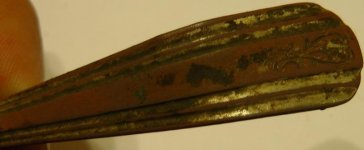I wrote this for cleaning salt water found silver coins, It should haelp a lot.
Silver coins from salt water enviroments can be very tough to get clean. The build up, and the black just won't come off it seems with any one method. The ship wreck coins usually go through many different treatments including electrolysis, which I don't care for as it tends to like to pit things of copper / silver. Not to mention that isn't necessary.
I found this combination of things work well, and relatively quickly.
#1, a soak in 10% solution of muriatic acid, don't be too concerned about exact percentages here, and slowly put acid in water not other way round. I let this soak for a day. Perhaps less time is enough, but it will not hurt the coin regardless. and this is the first step that the ATOCHA coins had done to them, although I think they said 10 or 20 minutes.
This tended to removed the real crusty looking stuff, but the black remained.
#2, The tin foil method, while this seems to little all by itself there is definitely something going on here. Wet the coin, and tinfoil with a solution of baking soda, and water. wrap the coin shinny side of foil toward the coil, and press tight with your fingers or place it under something, the goal is to make contact, as in electrical. Leave a couple of minutes this way 2 to 3 is enough.
#3, rub the coin with ordinary table salt, and just enough drops of water, you'll know how much, add salt, and drops of water as necessary. You will see the black comming off.
Repeat steps 2 and 3 as necessary or untill desired color remains, or is completely "new" looking silver. In my case with these two coins it was 3 repeats of step 2 and 3.
I've done other too, that were near unrecognizable to looking like new, just don't have before pics, so little point to show them
I WOULD use this on a rare coin too.
Please reserve negative comments about how I ruined the value here.
Before, and after pics.



